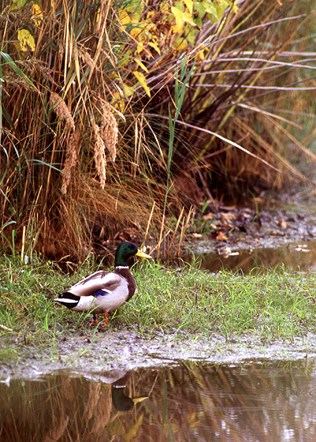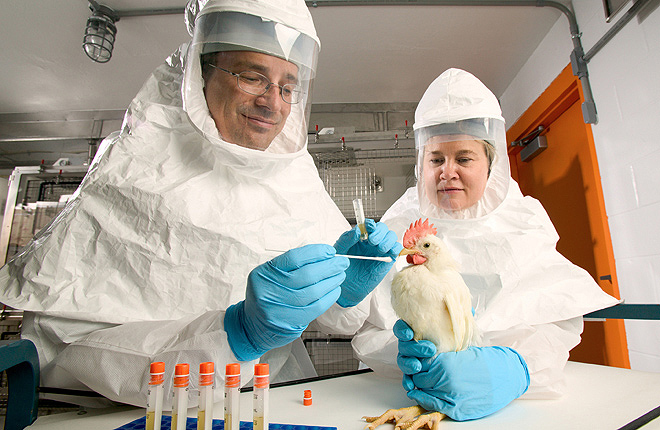Going Overseas To Protect U.S. Poultry
Why would Agricultural Research Service (ARS) scientists based in Athens, Georgia, travel to countries like Mongolia and Nigeria to help control outbreaks of avian influenza? What’s in it for U.S. farmers and taxpayers?
The answer is plenty.
|
|
Outbreaks almost always originate with infected waterfowl, usually ducks, which can migrate from one country to the next.
“Waterfowl networks are all interconnected, so if we can help control avian flu overseas, it is less likely to show up in the United States,” says David Swayne, director of the ARS Southeast Poultry Research Laboratory in Athens.
Swayne notes that Canada, the United States, and Mexico share common flyways. Waterfowl also migrate from Asia to Alaska, where they share summer breeding grounds with birds from the western and midwestern United States. That means that an influenza strain from Asia, Canada, or Mexico could eventually find its way into the continental United States.
Swayne and his colleagues have been traveling the world for more than a decade to help scientists set up surveillance networks to monitor for outbreaks and to minimize the damage once an outbreak occurs.
The financial effects of an outbreak can be devastating. Millions of chickens and turkeys often have to be destroyed when there’s an outbreak, and if the virus is a highly pathogenic form, export markets are sometimes closed to producers in an entire country. The 2014-2015 outbreak in the Midwest forced farmers to destroy around 50 million chickens and turkeys, and losses to producers and related businesses reached $3.3 billion, according to U.S. Department of Agriculture estimates.
Globally, 40 billion chickens and turkeys are produced every year, and ARS’s international efforts help developing countries protect a vital protein source for their populations. “Keeping avian flu in check is the right thing to do from a humanitarian perspective, because it helps ensure global food security,” Swayne says.
 Avian influenza outbreaks can originate with infected waterfowl, usually ducks, which can migrate from one country to another. (Scott Bauer, K8307-9) |
Swayne and his ARS colleagues have been working with scientists in Mexico since the 1990s. In the past decade, they have traveled to Egypt, Kenya, Ukraine, Nigeria, Indonesia, Vietnam, and the Falkland Islands. The needs and challenges vary with each trip, but they often focus on helping scientists and health officials set up surveillance networks. Effective surveillance includes collecting samples from poultry farms and testing for infection. This can be a challenge in developing countries with limited personnel and funds.
Swayne has also invited scientists from all over the world to ARS’s Athens laboratory to provide guidance on how they can select and evaluate vaccines, isolate virus from samples, and conduct DNA tests to identify virus strains that may be infecting a flock.
ARS scientists often coordinate trips and share findings with international teams of scientists working on vaccines through the United Nations Food and Agriculture Organization and the World Organisation for Animal Health.
A major challenge with avian flu is identifying the source of an outbreak. Poultry can be infected when they are kept outdoors, sharing food, ground, living space, and water that may be contaminated with feces. Keeping poultry indoors reduces the risk, but is no guarantee. Farm workers can carry the virus into a poultry shed or barn on their boots or clothing. This is one of the ways that the 2014-2015 outbreak in the Midwest spread.
The work also is challenging because the virus is a moving target for vaccine developers. It constantly mutates, and there are endless genetic mutations that can occur within virus subtypes. For example, an H5N1 strain in Egypt or Pakistan might be very different from an H5N1 strain found elsewhere in terms of its virulence and the potential for avian mortality.
|
|
The pace of international efforts picked up in 2006 when scientists from the U.S. Department of Agriculture’s Animal and Plant Health Inspection Service (APHIS) asked Swayne to work with their international team in Indonesia to see why a vaccine being used to control an H5N1 outbreak wasn’t working. They found two contributing factors. First, the outbreak virus had mutated, so the vaccinated birds were not producing antibodies that could protect them against the new strain. Second, they found vast differences in vaccine quality. Some were potent, but others were weaker and unlikely to trigger a protective immune response. “In the early days, the vaccines often just weren’t strong enough,” Swayne says.
Once a vaccine is developed, it is usually effective for about 2 to 4 years before virus mutations make it obsolete. Some countries will vaccinate poultry in the event of a virulent outbreak, but vaccinating flocks can have economic consequences. Some countries prohibit imports of vaccinated poultry. A U.S. supply of stockpiled vaccine is available for emergencies, but has never been used. Swayne and other experts say helping out overseas is one way to keep outbreaks in check and ensure that U.S. vaccines will never need to be used, so ARS researchers plan to continue offering help whenever possible.
“The virus isn’t going to completely disappear any time soon, and it shows no signs of slowing down, so why should we?” Swayne says.—By Dennis O’Brien, ARS Office of Communications.
Key Facts
- Globally, 40 billion chickens and turkeys are produced every year.
- Infected migratory birds, like ducks, are a common source of avian flu outbreaks.
- ARS helps other countries set up surveillance networks for avian flu.
- ARS’s international work helps keep avian flu viruses out of the United States.
Full Story









